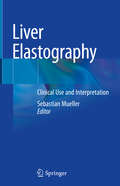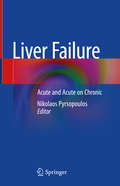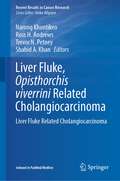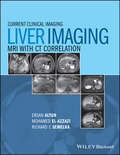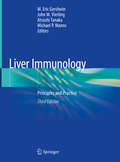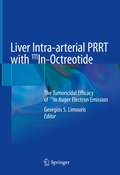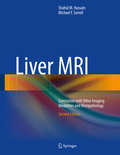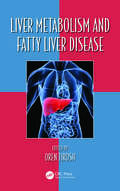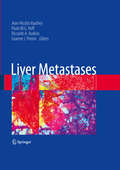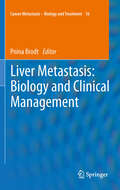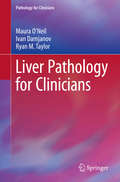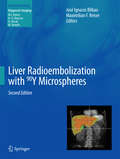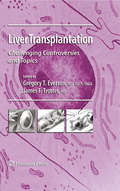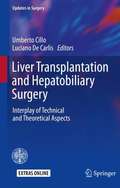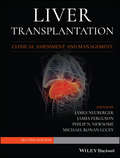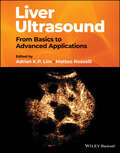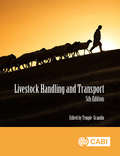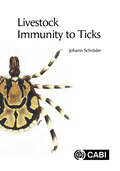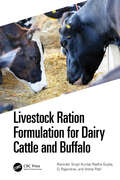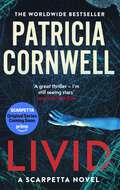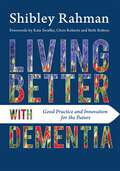- Table View
- List View
Liver Elastography: Clinical Use and Interpretation
by Sebastian MuellerThis is the first comprehensive book on the new elastographic techniques discussing the early assessment of liver fibrosis. The book covers all aspects of measuring liver stiffness starting from the methodology, the molecular basis of liver stiffness elevation up to current clinical algorithms and interpretation. Future directions and novel implications that go beyond diagnosis but are relevant for understanding of liver cirrhosis per se are also discussed in detail. Liver Elastography, is an essential companion for hepatologists and gastroenterologists that provides an overview of its basic principles and gives a detailed account of how to use elastrography in clinical practice.
Liver Failure: Acute and Acute on Chronic (The\clinics: Internal Medicine Ser. #22-2)
by Nikolaos PyrsopoulosThis book offers a comprehensive overview of liver failure including Epidemiology, mechanism of the disease, and its clinical manifestations. The diagnosis of numerous types of liver disease leading to liver failure; with specific emphasis on the current and future treatment modalities including up-to-date and extensive information on liver transplantation. It provides the most up-to-date information on liver failure for clinicians, practitioners including GPs, scientists/researchers, postgraduates and allied health professionals. It features an overview of the relevant classification and epidemiologic aspects of acute liver failure along with a thorough review of the mechanisms associated with acute liver failure and multisystemic involvement. Detailed guidance is also provided on the latest treatment techniques including those available for liver transplantation and potential future approaches, enabling the reader to develop a detailed understanding of the topic. Liver Failure: Acute and Acute on Chronic provides a practically applicable guide to the epidemiology and management of liver failure. It features contributions from an outstanding panel of experts in hepatology, gastroenterology and surgery making it a vital up-to-date reference for trainee and practicing medical professionals in a variety of disciplines who encounter these patients.
Liver Fluke, Opisthorchis viverrini Related Cholangiocarcinoma: Liver Fluke Related Cholangiocarcinoma (Recent Results in Cancer Research #219)
by Trevor N. Petney Narong Khuntikeo Ross H. Andrews Shahid A. KhanThis volume discusses new developments in the etiology, diagnosis, and treatment of cholangiocarcinoma induced by the liver fluke Opisthorchis viverrini. Although cholangiocarcinoma is rare in the Western world, it has a very high incidence in continental Southeast Asian countries, where it is linked to infection with O. viverrini. In Southeast Asia this cancer causes thousands of deaths every year and places a severe socioeconomic burden on the affected families. Diagnosis is usually at a late disease stage, and in the past palliative surgery and care have been the major therapeutic options. Recently, however, techniques have become available for early-stage diagnosis that offer the possibility of curative surgery, and novel chemotherapeutic options are also under development. In Thailand alone, more than 2 million individuals have now been registered for screening for this cancer. The aim of this book is to highlight the latest research in the field and to explain how the newly available techniques can be applied to reduce the risk of developing cholangiocarcinoma and increase the likelihood of survival.
Liver Imaging
by Richard C. Semelka Mohamed El-Azzazi Ersan AltunThe first single source work to deal with the two primary radiologic modalities in diagnosing and treating benign and malignant diseases of the liver, presented with clearly laid out MRI and CT correlations. Developed by an editor team led by one of the world's leading authorities in abdominal imaging, Richard C. Semelka MD. User-friendly, atlas-style presentation, with over 1500 MRI and CT images in over 320 figures featuring state-of-the-art MR and CT imaging sequences, multidetector row CT images, 3D reformatted images, breath-hold MRI sequences, and cutting-edge MR 3T images Highly practical approach for imaging of focal and diffuse liver lesions, complete relevant and systematic (differential) diagnostic information, the latest references to primary literature and clinical evidence, and patient management possibilities Reflects a pattern-recognition approach to MRI and CT imaging, assisting with efficient scanning of images and assessment and diagnosis of disorders
Liver Immunology
by M. Eric Gershwin Michael P. Manns John M. VierlingLiver Immunology: Principles and Practice, Second Edition begins with important information about the epidemiology and mortality of liver disease worldwide. This information is followed by chapters related to basic immunology, application of liver immunology for diagnosis, and several excellent chapters that provide a solid foundation for understanding immune-mediated liver disease, including those associated with the biliary tree. A chapter on non-hepatic manifestations of immune mediated liver disease helps provide context for how these diseases affect the patient overall. In addition, chapters discuss various discrete immunologically-mediated infectious liver disorders including those related to bacteria, parasites, and all of the classic viruses. Chapters on the traditional autoimmune liver diseases -- primary biliary cirrhosis, autoimmune hepatitis, primary sclerosing cholangitis as well as overlap syndrome - are also included. The breadth of this comprehensive second edition is highlighted by chapters on alcoholic liver disease, non-alcoholic fatty liver disease, and drug-induced liver disease, among others. This invaluable new edition ends with a forward-looking view of future directions and how the field might meet the challenge of refractory patients. Developed by a renowned group of authors, Liver Immunology: Principles and Practice, Second Edition will again serve as a comprehensive textbook by providing an excellent overview for this rapidly evolving field. It greatly adds to the understanding of the pathogenesis of these diseases, while also providing novel insights that can be harnessed into helping improve the care of patients afflicted with various immune-mediated diseases. This volume will again be a must-read for clinicians at all levels, investigators and students.
Liver Immunology: Principles and Practice
by M. Eric Gershwin Michael P. Manns John M. Vierling Atsushi TanakaThe third edition of this acclaimed work provides clinicians and investigators with a wealth of state-of-the-art information that will lead to fresh approaches in thinking about liver physiology and liver diseases. Developed by a panel of renowned international authors, this edition outlines a range of important advances in our understanding of the liver’s role as an immune organ and the functions of innate and adaptive immunity in the pathogenesis of all liver diseases. Indeed, the liver is a vitally important immune organ producing liver-derived products that can trigger the innate and adaptive immune system to initiate, mediate, regulate, and resolve systemic inflammation. The book begins with an analysis of the core concepts of immunology, including the definition of autoimmunity and its unique application to the liver, a tolerogenic organ. Subsequent chapters then explore the biological elements of liver diseases caused by epigenetics, genetics, and innate and adaptive immunity. Specific clinical presentations and aspects of liver diseases are also examined, such as Hepatitis C, non-alcoholic fatty liver disease and parasitic infections. Closing chapters then discuss liver diseases among specific populations, including pediatrics, those with comorbidities and preexisting conditions, pregnant women, and finally patients with transplanted organs. A timely and invaluable update to the clinical literature, Liver Immunology: Principles and Practice, Third Edition, is once again a comprehensive work that will not only enhance the understanding of liver diseases but also provide the kind of novel insights that greatly accelerates the evidence-based care of children and adults afflicted with these diseases. This volume is again a must-read for clinicians at all levels, for investigators and for students.
Liver Intra-arterial PRRT with 111In-Octreotide: The Tumoricidal Efficacy of 111In Auger Electron Emission
by Georgios S. LimourisThis book describes in detail a clinical project that reveals the tumoricidal efficacy of Auger and internal conversion electrons, emitted from n.c.a. 111In and implemented in oncology as a treating armamentarium for peptide receptor radionuclide therapy (PRRT), targeting small size (ø ≤ 20 mm) tumors and micro-metastases.The keen interest in n.c.a. 111In began when it was observed that its Auger electron emission could be highly radiotoxic, due to its high LET when it decayed in the vicinity of cellular DNA. The somatostatin analog octreotide, labeled with [111In-diethylenetriaminepentaacetic acid (DTPA0-D-Phe1)] is an established diagnostic agent for the imaging of somatostatin receptor-positive neuro- (or non-neuro) endocrine tumors. It relies on receptor-mediated binding, internalization and installation in the lysosomes in the proximity of the nucleus; administered in large doses, loco-regionally, via the feeding artery of solid tumors, can be highly radiotoxic if they over-express somatostatin receptors, mainly of the sst2 histotype.The book compares the results between i.v. and i.a. implementation in more than 80 patients after over 800 i.a. infusions in neuroendocrine tumors, meningiomas, paragangliomas and colorectal carcinomas in a single Institute (Aretaieion University Hospital) and encourages the i.a. way, leading to “tumor melting”, while minimizing the toxicity to healthy peritumoral liver tissue and critical organs (kidneys and bone marrow).The volume is an invaluable tool for nuclear medicine physicians, interventional radiologists and oncologists dealing with radiopeptide therapies.
Liver MRI
by Michael F. Sorrell Shahid M. HussainThe second edition of this very successful book provides a practical approach to liver MRI, with coverage of the most up-to-date MR imaging sequences, normal and variant anatomy and diverse pathologic conditions. It features computer-generated drawings relating clinical concepts to the MRI findings, 2D and 3D reconstructions, systematic (differential) diagnostic information and descriptions of patient management options. MRI findings are correlated to ultrasound, computed tomography, nuclear medicine exams, laboratory findings and histopathology when appropriate. New information is presented on a wide range of topics and more than 50 extra figure pages are included. This book will greatly benefit all professionals interested and involved in imaging, diagnosis and treatment of focal and diffuse liver lesions, including radiologists, gastroenterologists, hepatologists, surgeons, pathologists, MR physicists, radiology and other residents, MR technologists and medical students. p>
Liver Metabolism and Fatty Liver Disease (Oxidative Stress and Disease #34)
by Oren TiroshAbout 30% of the general population suffers from Non-Alcoholic Fatty Liver Disease, and the incidence of more serious fatty liver disorders increases with obesity. This discusses the current understanding of development of liver disease and the clinical aspects of fatty liver disease by examining the current knowledge regarding the absorption, metabolism of fat in the liver. It summarizes the current knowledge regarding the involvement of oxidative stress, the metabolic effects inflammation, and the effect of nutrition in the disease development and progression.
Liver Metastases
by Riccardo A. Audisio Paulo M. Hoff Jean-Nicolas Vauthey Graeme J. PostonThis book addresses the contemporary multidisciplinary management of liver metastases. Throughout the text, experience from the paradigms of colorectal cancer metastases treatment strategies are used to point to new directions in the management of liver metastases from other cancers. The book will be invaluable for surgeons in general surgery, hepatobiliary surgery, upper GI surgery, colorectal surgery, medical and clinical oncologists with an interest in liver tumours, and radiologists with an interest in liver disease.
Liver Metastasis: Biology and Clinical Management
by Pnina BrodtLiver metastases are a frequent and often fatal occurrence in cancer patients, particularly those with malignancies of the gastrointestinal (GI) tract. While recent improvements in surgical techniques and a more aggressive approach to resection of liver metastases have improved long term survival for some patients, most patients with hepatic metastases still succumb to their disease. To improve these dismal statistics, a better understanding of the biology of liver metastasis, particularly the early stages that can be targeted for prevention, is essential. Once cancer cells enter the liver, several different scenarios may occur. The cancer cells may be immediately destroyed by local defence mechanisms, they may enter a state of dormancy as solitary cells and never produce a metastasis, initiate a short-lived process of proliferation that is aborted before a metastasis is established or actively proliferate to form macrometastases. The chapters in Part I of this book provide insight into the cellular/molecular mechanisms that determine which of these scenarios prevails. Written by experts researchers in the filed of metastasis, these chapters provide state-of-the art reviews on the cellular and molecular processes that impact the early stages of the metastatic process. The unique microenvironment of the liver, its various anatomical, cellular and molecular features and the impact they have on metastasis are highlighted. In addition, the role of inflammation (pre-existing and tumor-induced), host innate and adaptive immune responses, cytokines, chemokines, growth factors and the unique molecular signatures of metastatic tumor cells are reviewed with an underscoring of the translational implications of the current state of knowledge. Against this background, the chapters in Part II of the book provide critical reviews on major aspects of the clinical management of hepatic metastases. These include imaging strategies, surgical and chemotherapeutic treatment approaches and the use of targeted biological therapeutics such as anti-angiogenic drugs as treatment modalities. By combining information on biological and clinical aspects of liver metastasis, this volume will serve as an excellent resource for scientists, clinicians, clinician/ scientists and trainees in the domains of oncology, surgical oncology, hepatobiliary physiology and radiology.
Liver Pathology for Clinicians
by Maura O'Neil Ivan Damjanov Ryan M. TaylorThis is the first volume in a new Springer series, Pathology for Clinicians, which aims to assist clinicians in their daily decision making by providing reliable, clearly presented information on current techniques in pathology, their uses and indications, clinical-pathologic correlations, and the significance of pathologic diagnoses. Liver Pathology for Clinicians first discusses key technical aspects of liver biopsy, including the use of special stains and immunohistochemistry. Detailed guidance is provided on both common and uncommon indications for liver biopsy, including repeat or serial biopsies, and on the choice of procedure. The role of liver biopsy in the contexts of transplantation and systemic disease is also clearly explained. Clinical-pathologic correlations are presented with the aid of high-quality illustrations.
Liver Radioembolization with 90Y Microspheres
by José Ignacio Bilbao Maximilian F. ReiserThis is the second edition of a very well received book devoted specifically to the treatment of liver tumors by radioembolization with 90Y microspheres. The success of the first edition was based on the provision of all the fundamental information required for successful use of this therapeutic modality in clinical practice. The new edition has been fully updated to cover the most recent advances and includes additional chapters on regulations and emerging trends. Detailed information is provided on the full range of relevant topics, including hepatic vascular anatomy (including variants), dosimetry, assessment of tumor response, and the results achieved using radioembolization alone and in combination with other treatments in patients with primary or metastatic disease. Complications and side-effects are also fully discussed. This book will prove immensely valuable for both beginners and practitioners.
Liver Transplantation
by Gregory T. Everson James F. TrotterThe field of liver transplantation is young, evolving, dynamic, and issues and decisions are often controversial, thus a text with a different focus is required, one that highlights controversy and challenges dogma. In Liver Transplantation: Challenging Controversies and Topics a useful set of chapters have been created that will take the reader step-by-step through key areas of controversy in the field of liver transplantation. The authors have tried to anticipate questions, define key issues, and provide options for resolving or approaching areas of uncertainty. The topics covered in this book impact our understanding and management of immunosuppressant, viral hepatitis, nonalcoholic fatty liver disease, organ allocation, regional differences in rates of transplantation, and hepatocellular cancer. All authors are actively practicing physicians and surgeons who deal with all the issues presented on an ongoing and daily basis. Throughout the book, emphasis is put on the need for thoughtful well-controlled clinical and basic research of transplant hepatology and liver transplantation. There is also speculation on potential breakthroughs in immunology, virology, cell biology, surgery and medicine that might influence or impact the future directions of these fields of medicine. Liver Transplantation: Challenging Controversies and Topics is an important new book meant to stimulate interest, identify topics requiring additional study, and to promote discourse among transplant professionals.
Liver Transplantation
by James Ferguson James Neuberger Philip N. NewsomeLiver Transplantation: Clinical Assessment and Management is the perfect tool for all gastroenterologists, hepatologists and transplant surgeons managing patients with liver disease awaiting and undergoing transplantation. Led by James Neuberger, world experts in hepatology and transplantation provide a chronological, step-by-step approach to best clinical management and patient care. Evidence-based throughout and with reference to the very latest practice guidelines from major societies such as EASL and AASLD, the book covers:When to refer a patient for liver transplantationSelection, assessment and management on the listTransplantation for acute liver failureDonation and allocationCare of the liver transplant recipient80 high definition videos of transplant surgery allow you to watch the experts in action and provide an outstanding visual and teaching element. In addition, key points, potential pitfalls, management algorithms, and useful weblinks all help ensure rapid reference browsing. If you're managing patients requiring a liver transplant, this multimedia resource will save you time and effort by putting essential information within easy reach.
Liver Transplantation and Hepatobiliary Surgery: Interplay of Technical and Theoretical Aspects (Updates in Surgery)
by Luciano De Carlis Umberto CilloIn the past, liver resections and liver transplantations were performed by different surgical teams, with very little interplay between the two. However, the evolution toward more complex operations called for an increasingly intense interaction between these surgical techniques: split liver and living donor liver transplantation have become popular in the transplant community, utilizing the Coinaud segmental anatomy in a very sophisticated way, while portal and arterial resection and reconstruction have become indispensable methods for treating Klatskin tumors infiltrating the hepatic hilum. This book offers a complete overview of the connections between liver transplantation and hepatobiliary surgery. It focuses on ex situ techniques for resection of tumors at the suprahepatic confluence, with or without venous reconstruction, and on total vascular exclusion of the liver with the aid of a venovenous bypass that should be a surgical option for referral centers in hepatopancreatobiliary surgery. By taking into consideration the development of minimally invasive liver surgery, it will introduce readers to a variety of new perspectives such as: vascular exclusion techniques with or without extracorporeal circulation, hemodynamic implications and lessons learned from liver transplant surgery, and technical details on pediatric transplantation and its informative role in modern biliary tract surgery.
Liver Transplantation: Clinical Assessment and Management
by James Ferguson James Neuberger Philip N. Newsome Michael Ronan LuceyExplore this practical and step-by-step guide to managing liver transplant patients from leading international clinicians in Hepatology The newly revised Second Edition of Liver Transplantation: Clinical Assessment and Management delivers expert clinical guidance on best practices in managing the care of liver transplant patients. Authors are all experts in their field and cover a world-wide perspective. Organized in an accessible, stepwise fashion and packed with text features such as key points, the book covers all critical areas of each stage of the liver transplant journey, from assessment, to management on the list, to long term care. Readers will learn when to refer a patient for liver transplantation, how to assess a potential liver transplant recipient, learn the principles of the procedure and the long term management of the transplant recipient. Liver Transplantation provides the entire hepatology and surgical team the information required for a sound understanding of the entire procedure, from pre- to post-operative care and management. Clinically oriented and management-focused, the book is far more accessible than the liver transplant sections in traditional hepatology textbooks. Readers will also enjoy: A thorough discussion of when to refer a patient for liver transplantation, including general considerations and the use and abuse of prognostic models An exploration of the selection, assessment, and management of patients on the transplant list, including how to manage a patient with chronic liver disease while on the waiting list A treatment of liver transplantation for acute liver failure (ALF), including assessment and management of ALF patients on the transplant waiting list A discussion of care of the liver transplant recipient after the procedure in the short and long term Perfect for gastroenterologists, hepatologists, and surgeons and other health care professionals managing patients with liver disease who are awaiting, undergoing and following liver transplantation, Liver Transplantation: Clinical Assessment and Management will also earn a place in the libraries of medical students, residents, internal medicine physicians, and GI/Hepatology trainees and all health care professionals providing clinical care to people with liver disease, before, during and after transplantation.
Liver Ultrasound: From Basics to Advanced Applications
by Matteo Rosselli Adrian K.P. LimLiver Ultrasound An up-to-date discussion of modern liver ultrasound techniques, combining hepatological and radiological perspectives into one stand-alone resource. In Liver Ultrasound: From Basics to Advanced Applications, a team of distinguished experts delivers an in-depth textbook on how to perform liver ultrasound and interpret common and uncommon clinical findings. The authors also walk readers through the nuances of ultrasonic and parametric features, from both a radiological and hepatological perspective, in differentiating the multitude of liver conditions. They also discuss clinical evaluations and how to use more advanced and currently evolving techniques. Readers will experience well-illustrated and clear ultrasound images while also getting access to a complimentary website that features numerous videos which integrate the book’s modern and multidisciplinary approach. The book also includes: A thorough introduction to the basics of ultrasound, as well as ultrasound scanners and knobology Comprehensive explanations on how to perform a liver ultrasound, including routine practicalities, discussions of normal liver anatomy, normal variants and advanced Doppler techniques Practical discussions of focal liver lesions, including their characterization and detection and how contrast enhanced ultrasound plays a pivotal role A clinical overview on the use of point of care ultrasound in liver disease as well as the use of ultrasound in liver related infectious diseases, biliary disorders and pediatric liver disease An extensive overview on the use of ultrasound and specific findings in liver transplantation The role of ultrasound in chronic liver disease, vascular liver diseases and interventional procedures, as well as discussions on advancing technologies namely shearwave elastography, attenuation imaging and fusion Perfect for all who perform liver sonography namely, hepatologists, radiologists, internal and emergency medicine physicians and sonographers. Liver Ultrasound: From Basics to Advanced Applications will also benefit trainees from all these specialties.
Livestock Handling and Transport: Principles And Practice
by Raymond Coppinger Lorna Coppinger Anna Johnson Pete Goddard Katherine A. Houpt Clive Phillips Donald Broom Michael Cockram Paul Hemsworth Miriam Parker Stella Maris Huertas Edmond A. Pajor Adrian Barber Faith Baier Keith Belk Michelle S. Calvo-Lorenzo Trevor DeVries Roger Ewbank Luigi Faucitano Robert B. Freeman Wendy K. Fulwider Carmen Gallo Arlene Garcia-Marquez Geoffrey D. Hutson Mateus J.R. Costa Matthew J. Ritter Karen Schwartzkopf-Genswein Meagan King E. Bert Lambooij Genaro C. Lama Pol Llonch Obiols Emma Fabreger Romans Frank Tuyttens Antonio Velarde Kurt Vogel Claire A. Weeks Carissa L. WickensEdited by world-renowned animal scientist Dr Temple Grandin, this practical book integrates scientific research and industry literature on cattle, pigs, poultry, sheep, goats, deer, and horses, in both the developed and developing world, to provide a practical guide to humane handling and minimizing animal stress. Reviewing the latest research on transport systems, restraint methods and facilities for farms and slaughterhouses, this fully updated fifth edition of Livestock Handling and Transport includes five new chapters: The Introduction, Genetics and Handling, Goat Handling and Transport, Robotic Milking, and Transport of Livestock by Sea. There is also new coverage of temperament testing and change, the principles of good stockmanship as well as including new video material to further explain key information contained in the book. Key features include: - Edited by world-renowned animal scientist Temple Grandin. - Two new chapters on the testing and control of temperament and the principles of good stockmanship. - Online videos to further illustrate the key points.
Livestock Immunity to Ticks
by Johann SchröderAs arthropod ectoparasites, ticks threaten the wellbeing of the animals whose habitat they share. They cause skin damage from their bite wounds, secrete toxins, transmit pathogens, and can also induce allergic reactions and infected wounds. For more than a century, domestic animals have undergone chemical tick treatment as part of their husbandry routine. However, this reliance on chemicals is non-sustainable, and ignores the existence of other possible avenues of tick management. Covering recent developments in the field, this book considers avenues such as: - Managing infestations through both natural tick control and human intervention - Innate tick resistance - Naturally acquired adaptive immunity - Technological developments and successes such as vaccination schemes The book also takes into consideration the barriers any one of these solutions may face on the road to commercialization. Livestock Immunity to Ticks provides a comprehensive and up-to-date resource for researchers and students of immunology, parasitology and entomology.
Livestock Ration Formulation for Dairy Cattle and Buffalo
by Ravinder Singh Kuntal Radha Gupta D. Rajendran Vishal PatilLivestock Ration Formulation for Dairy Cattle and Buffalo provides an interdisciplinary, integrative perspective and optimization on dairy cattle feed formulation problem solving. It helps dairy farmers by introducing them the right frequency and right amount of balanced diet to be fed to cattle’s and buffaloes at different body condition so that their feeding cost should be decreased and there should be increase in income for dairy farmers, as they don’t have enough knowledge of feeding practice. It helps animal nutritionist to work for dairy farmers which have very limited feed resources to fulfil nutrients requirement in terms of crude protein (CP), total digestible nutrient (TDN), calcium (Ca) and phosphorus (P) by developing a software programme to plan a balanced low budget diet. It includes the Linear and Goal programming model for non-pregnant dairy buffalo is been solved using Hybrid Real Coded Genetic Algorithm and the results are compared with Real Coded Genetic Algorithm (RGA) considering different versions like RGA without crossover, RGA without Mutation, RGA with crossover and mutation. These models can also be applied with other nutritional models like CNCPS, INRA. This book is a step forward in that direction to provide least cost diet formulation based on nutrient requirement of the cattle and buffalo, which is been calculated according to Indian Council of Agricultural Research (ICAR, 2013) and NRC (2001) on dry matter basis, provides a clear and precise platform for other researcher in Animal Nutrition field which also give initial platform to build a software and android application to formulate least cost ration Based on data and algorithm used in this book, which helps Dairy farmers directly to feed balanced diet at cheap rate. Features: It is a good reference to local dairy farmers by introducing them to the right frequency and right amount of balanced diet to be fed to cattle and buffaloes at different production cycles. It will provide basic platform and some solutions to built-up software about cattle nutrition development and least cost formulation for end-user. It has several techniques for optimizing animal diet formulation but a good balance between coding/programming and animal nutrition is incorporated towards application of soft computing technique to improve the quality of the solution due to rigidity of the constraints.
Livid: The new Kay Scarpetta thriller from the No.1 bestseller (Kay Scarpetta #26)
by Patricia CornwellTHE THRILLING NEW KAY SCARPETTA MYSTERY FROM THE #1 GLOBAL BESTSELLERMurder and mayhem. Scarpetta is back, and she's racing against the clock . . .Chief medical examiner Kay Scarpetta is the reluctant star witness in a sensational murder trial when she receives shocking news. The judge's sister has been found dead. At first glance, it appears to be a home invasion, but then why was nothing stolen, and why is the garden strewn with dead plants and insects?Although there is no apparent cause of death, Scarpetta recognizes tell-tale signs of the unthinkable, and she knows the worst is yet to come. The forensic pathologist finds herself pitted against a powerful force that returns her to the past, and her time to catch the killer is running out . . .'RIVETING' THE TIMES'CORNWELL KNOWS HOW TO CRAFT A MEAN PAGE-TURNER AND LIVID IS NO EXCEPTION' TELEGRAPH'ONE OF THE BEST CRIME WRITERS WRITING TODAY' GUARDIAN'GRIPPING . . . SOUND THE KLAXON, DR KAY SCARPETTA IS BACK' HEAT'ASTONISHING . . . THIRTY YEARS ON, THERE'S STILL NO OTHER CRIME WRITER LIKE HER' SUNDAY TIMES
Livid: The new Kay Scarpetta thriller from the No.1 bestseller (Kay Scarpetta #26)
by Patricia CornwellTHE THRILLING NEW KAY SCARPETTA MYSTERY FROM THE #1 GLOBAL BESTSELLER'I'M STILL SEEING STARS . . . KAY SCARPETTA IS THE SAME GRUMPY, WONDERFUL, RIVETING PERSONALITY SHE'S ALWAYS BEEN AND SHE'S ONLY GETTING BETTER WITH TIME' JAMES PATTERSONMurder and mayhem. Scarpetta is back, and she's racing against the clock . . .Chief medical examiner Kay Scarpetta is the reluctant star witness in a sensational murder trial when she receives shocking news. The judge's sister has been found dead. At first glance, it appears to be a home invasion, but then why was nothing stolen, and why is the garden strewn with dead plants and insects?Although there is no apparent cause of death, Scarpetta recognizes tell-tale signs of the unthinkable, and she knows the worst is yet to come. The forensic pathologist finds herself pitted against a powerful force that returns her to the past, and her time to catch the killer is running out . . .'RIVETING' THE TIMES'CORNWELL KNOWS HOW TO CRAFT A MEAN PAGE-TURNER AND LIVID IS NO EXCEPTION' TELEGRAPH'ONE OF THE BEST CRIME WRITERS WRITING TODAY' GUARDIAN'GRIPPING . . . SOUND THE KLAXON, DR KAY SCARPETTA IS BACK' HEAT'ASTONISHING . . . THIRTY YEARS ON, THERE'S STILL NO OTHER CRIME WRITER LIKE HER' SUNDAY TIMES
Living Better with Dementia: Good Practice and Innovation for the Future
by Chris Roberts Beth Britton Kate Swaffer Shibley RahmanWhat do national dementia strategies, constantly evolving policy and ongoing funding difficulties mean for people living well with dementia? Adopting a broad and inclusive approach, Shibley Rahman presents a thorough critical analysis of existing dementia policy, and tackles head-on current and controversial topics at the forefront of public and political debate, such as diagnosis in primary care, access to services for marginalised groups, stigma and discrimination, integrated care, personal health budgets, personalised medicine and the use of GPS tracking. Drawing on a wealth of diverse research, and including voices from all reaches of the globe, he identifies current policy challenges for living well with dementia, and highlights pockets of innovation and good practice to inform practical solutions for living better with dementia in the future. A unique and cohesive account of where dementia care practice and policy needs to head, and why, and how this can be achieved, this is crucial reading for dementia care professionals, service commissioners, public health officials and policy makers, as well as academics and students in these fields.
Living Better: How I Learned to Survive Depression
by Alastair CampbellTHE SUNDAY TIMES BESTSELLERLast Christmas I almost killed myself. Almost. I've had a lot of almosts. Never gone from almost to deed. Don't think I ever will. But it was a bad almost. Living Better is Alastair Campbell's honest, moving and life affirming account of his lifelong struggle with depression. It is an autobiographical, psychological and psychiatric study, which explores his own childhood, family and other relationships, and examines the impact of his professional and political life on himself and those around him. But it also lays bare his relentless quest to understand depression not just through his own life but through different treatments. Every bit as direct and driven, clever and candid as he is, this is a book filled with pain, but also hope -- he examines how his successes have been in part because of rather than despite his mental health problems -- and love. We all know someone with depression. There is barely a family untouched by it. We may be talking about it more than we did, back in the era of 'boys don't cry' - they did you know - and when a brave face or a stiff upper lip or a best foot forward was seen as the only way to go. But we still don't talk about it enough. There is still stigma, and shame, and taboo. There is still the feeling that admitting to being sad or anxious makes us weak. It took me years, decades even to get to this point, but I passionately believe that the reverse is true and that speaking honestly about our feelings and experiences (whether as a depressive or as the friend or relative of a depressive) is the first and best step on the road to recovery. So that is what I have tried to do here.
